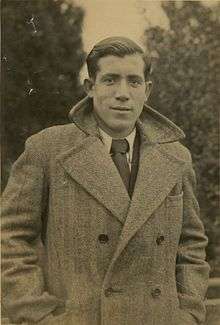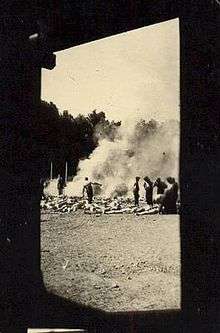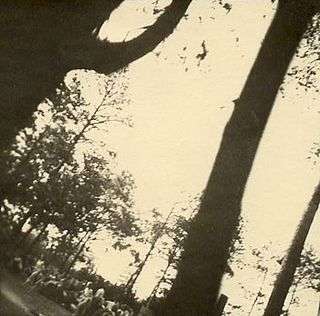Alberto Errera

Alberto Israel Errera[1] (Greek: Αλβέρτος Ερρέρα, born 15 January 1913 in Larissa and died in August 1944 in Birkenau) was a Greek-Jewish officer and a member of the anti-Nazi resistance. He was a member of the Sonderkommando in Auschwitz-Birkenau from May to August 1944.
He took part in the preparation of the Sonderkommando uprising. He is the author of the Sonderkommando photographs and became famous for a spectacular escape attempt.
Biography



Before the war, Alberto Errera became an officer in the Greek army (Navy). He joined the partisans during the German occupation of Greece. He took the Christian name Alex (Alekos) Michaelides. On the night of 24 to 25 March 1944, he was arrested by the Germans in Larissa, among 225 Jews.[2] He was jailed in Haidari camp.[3] He was deported from Athens on 2 April and arrived at Auschwitz on 11 April. He was one of the 320 Greek men selected for labor (serial numbers from 182,440 to 182,759). His number was 182,552. He was assigned as Heizer (that is to say, a member of the Sonderkommando assigned to the crematorium furnace) in Birkenau Krematorium V. Alter Fajnzylberg talks about his athletic build[4] and Leon Cohen describe his unusual strength.[5] According to Filip Müller,[6] Leon Cohen[7] and the historian Hermann Langbein,[8] he actively participated in the preparation of the Sonderkommando uprising alongside Yaacov Kaminski, Jankiel Handelsmann, Jukl Wrobel, Josef Warszawski, a man named Wladek, Giuseppe Baruch and Zalmen Gradowski,[9] among others.
Through the testimony of Alter Fajnzylberg,[10][11] we know that this is Errera who took the famous Sonderkommando photographs.[12][13][14] with the help of Dawid Szmulewski,[15] a member of the resistance, and three other members of the Sonderkommando, Szlama Dragon, his brother and Alter Fajnzylberg who kept watch.[16] Errera buried the camera in the soil of the camp.
On 9 August,[17] during the transport of ash from the Krematorium, to be discharged into the Vistula, Errera tried to convince his three co-detainees (including Hugo Baruch Venezia and Henri Nechama Capon) to escape, but they refused. Once on site, Errera stunned the accompanying two Schupos with a shovel, and plunged into the Vistula. He was caught during the next two or three days, tortured and killed. As usual when a fugitive was caught, his body was exposed at the camp entrance, as an example to the other inmates.
The Sonderkommando photographs
For many years, the author of the Sonderkommando pictures was not identified. They were credited as anonymous or, by default, assigned to Dawid Szmulewski, even if he mentioned a Greek Jew named Alex. The story of these photos was recorded by Alter Fajnzylberg in his writings in which he evokes the figure of the Greek Jew named Alex (although he forgot the surname). In May 1978, Fajnzylberg answered a letter from the Auschwitz-Birkenau Museum, about the photographs. He wrote:
However, in his diaries, written immediately after the war, Fajnzylberg mentions the attempted escape of a Greek Jew named Aleko Errera. His escape struck their minds and was told by several surviving witnesses: Errikos Sevillias,[19] Shlomo Venezia,[20] Leon Cohen,[21] Marcel Nadjary,[22] Dr. Miklos Nyiszli,[23] Alter Fajnzylberg,[24] Henryk Mandelbaum,[25] Albert Menasche[26] and Daniel Bennahmias.[27]
References
- ↑ See picture of Alberto Errera in the Jewish Museum of Greece: http://www.jewishmuseum.gr/dyncontent/repository/repository/15990/web_E5K_00129.jpg
- ↑ Gideon Greif, We wept without tears, Yale University Press, 2005, p. 375.
- ↑ Marcel Nadjary, Χρονικό 1941–1945 [Chronicle], Ιδρυμα Ετσ - Αχα'ι'μ, Thessaloniki, 1991, p. 36.
- ↑ Alter Fajnzylberg, Les cahiers d'Alter Fajnzylberg : ce que j'ai vu à Auschwitz, Éditions Rosiers, 2014.
- ↑ Leon Cohen, From Greece to Birkenau : the crematoria workers'uprising, Salonika Jewry Research Center, 1996.
- ↑ See Filip Müller, Eyewitness Auschwitz: Three Years in the Gas Chambers, Stein and Day, 1979.
- ↑ Leon Cohen, From Greece to Birkenau : the crematoria workers'uprising, Salonika Jewry Research Center, 1996.
- ↑ Hermann Langbein, People in Auschwitz, p. 217 : Kaminski and two Greeks who had participated in an earlier discussion of these plans with Porebski decided to organize a rebellion of the Sonderkommando, which had nothing to lose. The name of one of the two Greeks has been passed along; Eduard de Wind writes about Errera from Larissa and Albert Menasche mentions Alexander Hereirra. While Paisikovic does not remember the name, he does recall that a very intelligent Greek who was known on the detail for his beautiful singing took part in the preparatory work. The second Greek is probably Giuseppe Baruch, aka Pepo.
- ↑ (French) Zalmen Gradowski, Au cœur de l’enfer, Tallandier, 2009.
- ↑ Alter Fajnzylberg, Les cahiers d'Alter Fajnzylberg : ce que j'ai vu à Auschwitz, Éditions Rosiers, 2014.
- ↑ See Alban Perrin, Ecrits au cœur de la catastrophe : http://www.akadem.org/sommaire/colloques/ecrire-la-destruction-du-monde-judeo-polonais-1945-1960-/ecrits-au-coeur-de-la-catastrophe-2-2-09-07-2014-60879_4534.php
- ↑ About these photographs, see Georges Didi-Huberman, Images in Spite of All: Four Photographs from Auschwitz, University of Chicago Press, 2008, first published as Images malgré tout Les Éditions de Minuit, 2003.
- ↑ Gary Spicer, The Sonderkommando photographs : http://www.academia.edu/2552802/THE_SONDERKOMMANDO_PHOTOGRAPHS
- ↑ Steven Bowman, The Agony of Greek Jews, 1940–1945, Stanford University Press, 2009, p. 95
- ↑ See the testimony of Szmulewski in Jean-Claude Pressac, Technique and operation of the gas chambers, Beate Klarfeld Foundation, 1989. Online here : http://www.holocaust-history.org/auschwitz/pressac/technique-and-operation/pressac0424.shtml
- ↑ Hermann Langbein, People in Auschwitz , The University of North Carolina Press, 2004.
- ↑ After the German Auschwitz police station register of August 9, 1944. See the conference of Igor Bartosik in Brussels, 2013 : https://www.youtube.com/watch?v=mx9QflSlCSE
- ↑ See Alban Perrin, Écrits au cœur de la catastrophe : http://www.akadem.org/sommaire/colloques/ecrire-la-destruction-du-monde-judeo-polonais-1945-1960-/ecrits-au-coeur-de-la-catastrophe-2-2-09-07-2014-60879_4534.php
- ↑ Errikos Sevillias, Athens-Auschwitz, Lycabettus Press, 1983.
- ↑ Shlomo Venezia & Béatrice Prasquier, Inside the Gas Chambers: Eight Months in the Sonderkommando of Auschwitz , Polity, 2011.
- ↑ Leon Cohen, From Greece to Birkenau : the crematoria workers'uprising, Salonika Jewry Research Center, 1996.
- ↑ Marcel Nadjary, Χρονικό 1941–1945 [Chronicle], Ιδρυμα Ετσ - Αχα'ι'μ, Thessaloniki, 1991.
- ↑ Miklos Nyiszli, Auschwitz: A Doctor's Eyewitness Account ', Arcade Publishing, 2011.
- ↑ (French) Alter Fajnzylberg, Les cahiers d'Alter Fajnzylberg : ce que j'ai vu à Auschwitz, Éditions Rosiers, 2014.
- ↑ (French) Igor Bartosik et Adam Willma, Dans les crématoires d'Auschwitz – Entretien avec Henryk Mandelbaum, Auschwitz-Birkenau State Museum, 2012.
- ↑ Albert Menasche, Birkenau (Auschwitz II): Memories of an eyewitness : how 72,000 Greek Jews perished, Isaac Saltiel, New York, 1947
- ↑ Rebecca Camhi-Frome, The Holocaust odyssey of Daniel Bennahmias, Sonderkommando, University of Alabama Press, 1993.
External links
 Media related to Alberto Errera at Wikimedia Commons
Media related to Alberto Errera at Wikimedia Commons